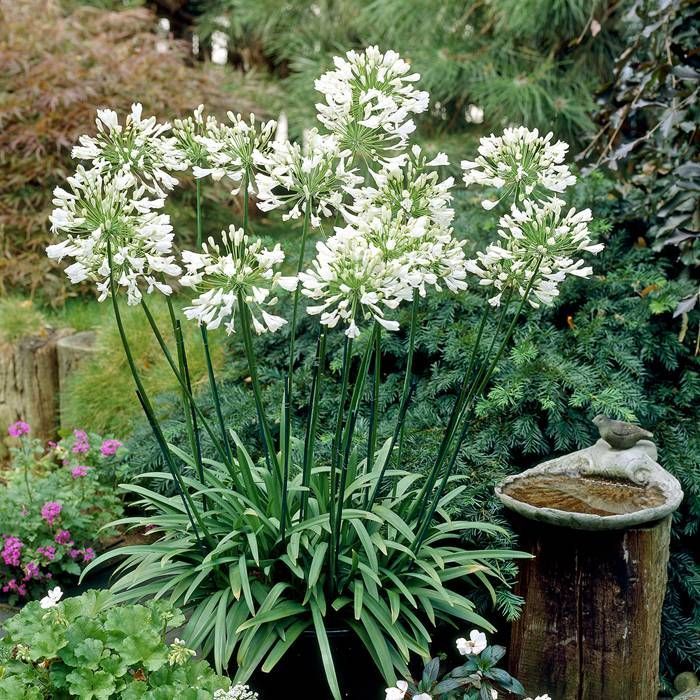Unlocking the Mysteries of Agapanthus: A Comprehensive Exploration of Selections, Growing Methods, and Upkeep Practices

Agapanthus, often shrouded in enigma because of its diverse variety of ranges and intricate upkeep demands, emerges as an enigmatic subject for numerous yard lovers. With a multitude of cultivars readily available, each boasting one-of-a-kind attributes and growth behaviors, understanding the intricacies of these plants can be both challenging and fulfilling. As we check out the subtleties of planting techniques and explore the essential upkeep practices needed to support these stunning blossoms, a globe of possibilities unfolds for those looking for to master the art of growing agapanthus.
Agapanthus Varieties Demystified
Agapanthus varieties show a varied range of qualities, making it essential for gardeners to recognize the differences between them for successful cultivation. The Agapanthus praecox, or Blue Lily of the Nile, is another popular alternative, flaunting huge spherical clusters of blue or white blossoms atop tall stalks.
For those seeking a more portable option, the Agapanthus 'Peter Pan' is a suitable choice, with its smaller stature and fragile blue flowers. On the other hand, the Agapanthus 'Storm Cloud' selection supplies a dramatic style with its deep purple flowers and dark vegetation (Agapanthus). In addition, the Agapanthus 'Albus' sticks out for its pure white blossoms, producing a stunning contrast in any type of garden setting
Recognizing these distinctions can aid gardeners pick the most suitable Agapanthus selection for their certain needs and choices, making sure a growing and dynamic garden display screen.
Growing Agapanthus Like a Pro
When planting Agapanthus for optimum growth and aesthetic impact, thorough interest to soil quality and sunshine direct exposure is critical. Agapanthus thrives in well-draining dirt with a slightly acidic to neutral pH degree. Before growing, amend compacted or heavy dirt with organic issue such as garden compost to improve water drainage and fertility. Choose a growing location that gets complete sunlight to partial shade, as Agapanthus usually likes a minimum of 6 hours of sunlight daily for robust blooming. When growing, guarantee the crown of the plant rests at soil level to protect against rot and urge healthy growth.

Essential Upkeep Tips for Agapanthus
To make sure the continued health and wellness and vigor of your Agapanthus plants, what key upkeep practices should be focused on throughout the growing season? Sufficient watering is necessary, specifically throughout the active development periods in spring and summer. Agapanthus plants like evenly wet dirt but can endure short periods of dry spell once established. Mulching around the plants can assist retain dirt moisture and control temperature level. Regular fertilizing is important to advertise growing and general plant health and wellness. Use a well balanced plant food with a higher phosphorus content to motivate flower production. Deadheading spent flowers can extend the blooming duration and improve the plant's look. Agapanthus plants take advantage of department every couple of years to protect against overcrowding, enhance growing, and rejuvenate the plant. Replant the departments in well-draining soil improved with natural matter. Maintain an eye out for usual pests and conditions, such as aphids or origin rot, and take punctual action to attend to any problems that might develop. By following these upkeep ideas, you can take pleasure in healthy and balanced and lively Agapanthus plants throughout the growing period.
Troubleshooting Common Agapanthus Issues
Identifying and promptly dealing with typical problems that might impact the health and wellness of your Agapanthus plants is vital for maintaining their vigor and appeal. One common issue that Agapanthus may deal with is overwatering, causing root rot. To avoid this, make sure appropriate drainage in the dirt and prevent waterlogging. Conversely, underwatering can create wilting and yellowing of leaves. To combat this, develop a routine watering timetable, making sure the dirt is damp but not waterlogged. Agapanthus are also at risk to bugs such as aphids and snails. Routinely check the plants for any indications of invasion and treat them without delay with appropriate approaches such as insecticidal soap or all-natural predators. Additionally, poor sunlight can lead to stunted development and fewer blooms. Guarantee your Agapanthus get adequate sunshine, preferably around 6-8 hours daily. By being attentive and attending to these common concerns promptly, you can help your Agapanthus prosper and prosper in your garden.
Making The Most Of Agapanthus Blooms: Specialist Techniques
Enhancing the vibrancy and wealth of Agapanthus blossoms requires a strategic method his comment is here that uses optimal expanding conditions and professional techniques. To optimize Agapanthus flowers, begin with choosing the ideal my sources selection for your area and desired aesthetic. Agapanthus varieties vary in height, bloom color, and flower time, so select one that fits your garden's requirements.
Plant Agapanthus in well-draining dirt with enough sunshine exposure. Routine watering, particularly throughout the active expanding period, is essential to avoid tension and motivate growing.
Feed Agapanthus with a balanced fertilizer to advertise flowering. Deadheading invested flowers can reroute the plant's energy right into generating new flowers (Agapanthus). Divide overcrowded clumps every couple of years to invigorate the plant and stimulate flowering
Finally, secure Agapanthus from insects and conditions that can hinder blooming. Executing these professional techniques will aid you attain a stunning display screen of Agapanthus blooms in your yard.
Verdict
In final thought, the enigmas of agapanthus have actually been introduced via a detailed exploration of selections, growing techniques, and upkeep practices. By repairing common issues and implementing professional techniques, one can optimize agapanthus flowers and create a stunning yard display.

When planting Agapanthus for optimum development and aesthetic effect, precise focus to dirt quality and sunlight direct exposure is critical.To grow Agapanthus like a pro, room the plants according to their fully grown Learn More Here size to enable for correct air circulation and avoid overcrowding. Agapanthus plants profit from department every few years to stop overcrowding, boost blooming, and revitalize the plant.In conclusion, the enigmas of agapanthus have actually been unveiled with a thorough expedition of varieties, planting strategies, and maintenance techniques.
Comments on “Agapanthus Proliferation: Tips for Expanding Your Plant Collection”